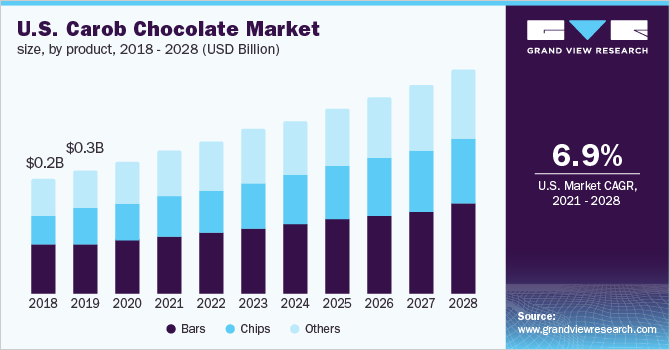Carob Chocolate Market Demand, Landscape And Latest Trends 2028
Carob Chocolate Industry Overview
The global carob chocolate market size was valued at USD 801.8 million in 2020 and is expected to grow at a compound annual growth rate (CAGR) of 6.4% from 2021 to 2028.
Carob is a caffeine-free and natural sweetener, due to which has a high demand across the globe. Moreover, the flourishing e-commerce sector is anticipated to boost the market further. The COVID-19 pandemic has had a devastating impact on the global food and beverage industry. Restaurants, bakeries, supermarkets, and other health stores were closed due to quarantine measures and lockdown orders, resulting in disastrous consequences and plummeting sales at an alarming rate since March 2020. This scenario, which was witnessed across the globe, affected the sales of carob chocolate products drastically.
Gather more insights about the market drivers, restrains and growth of the Global Carob Chocolate Market

The shifting consumer inclination toward healthier alternatives to cocoa powder is expected to expand the product scope. Carob powder, used to make chocolates, is high in calcium, fiber, and protein, and, thus, boasts of various health benefits. Furthermore, it contains virtually no saturated fat and no cholesterol, owing to which it is gaining popularity among health-conscious consumers.
In recent years, the millennial population has radically reshaped the food industry. Millennials have become more conscious about their health and fitness, and, thus, are willing to pay a premium price for product ingredients that are healthier and eliminate added sugars and caffeine. Citing these trends, numerous product manufacturers are launching various confectionery products, such as bars and treats.
People have been focusing on a healthy diet now more than ever to increase their immunity and maintain a balanced diet. Carob can be used to treat cancer and diarrhea and lower cholesterol levels, which, in turn, is significantly boosting its demand. Carob has various applications in the food and beverage industry; it has been gaining importance recently due to its rising application in confectionery, bakery, and other food & beverages products. However, the limited availability and the rising costs are hindering the manufacturing of carob chocolates.
Browse through Grand View Research’s Consumer F&B Industry Research Reports.
- Chocolate Market – The global chocolate market size was valued at USD 130.56 billion in 2019 and is expected to grow at a compound annual growth rate (CAGR) of 4.6% from 2020 to 2027.
- Carob Powder Market – The global carob powder market size was valued at USD 47.2 million in 2019 and is anticipated to witness significant growth over the forecast period.
Market Share Insights
- October 2020: The Carob World, a Portuguese company, launched carob flour in response to the increasing adoption of carob in the national and international markets.
- January 2020: Carobou, the official importer and producer of The Australian Carob Co., released organic carob chocolate bars under the brand Aussie USA, which is USDA-certified organic, soy-free, and caffeine-theobromine-free.
- December 2019: Missy J’s launched “Notella”, an unsweetened carob hazelnut spread. The product launch was in accordance with the dietary requirements of consumers.
Key Companies profiled:
Some prominent players in the global carob chocolate market include
- Missy J’s
- CAROBOU LLC
- The Carob Kitchen
- Uncommon Carob
- Foundations Food
- D&D Chocolates
- Iswari
- Caroboo
- Supertreats U.K.
- Carob World
Order a free sample PDF of the Carob Chocolate Market Intelligence Study, published by Grand View Research.